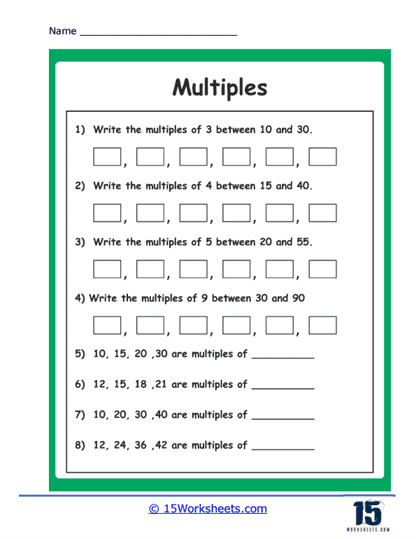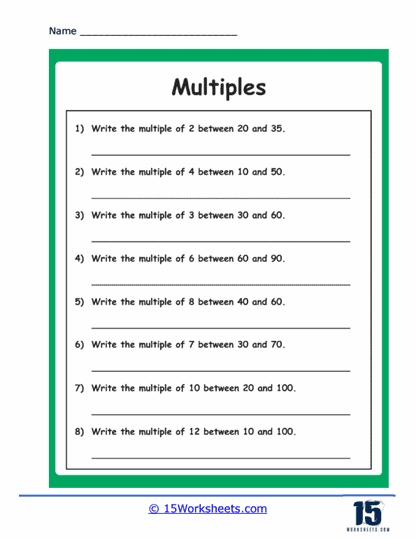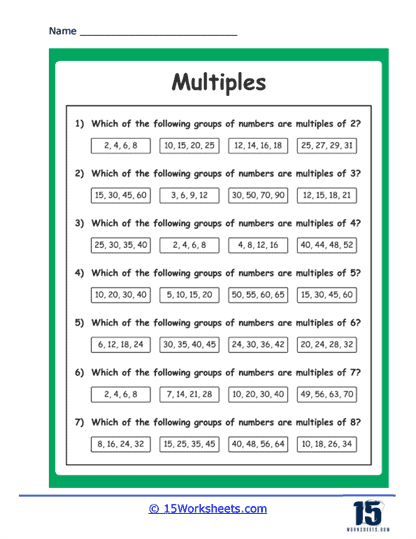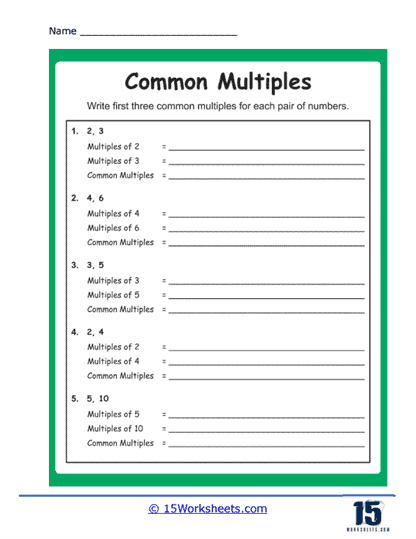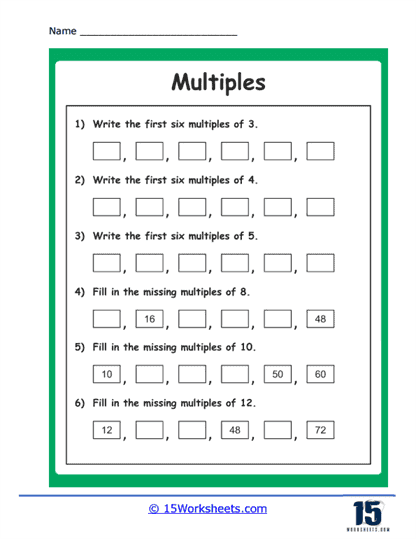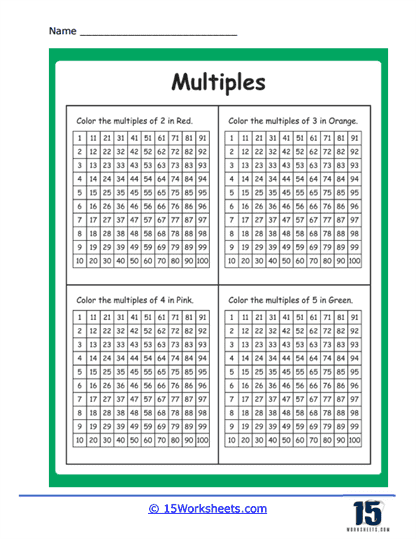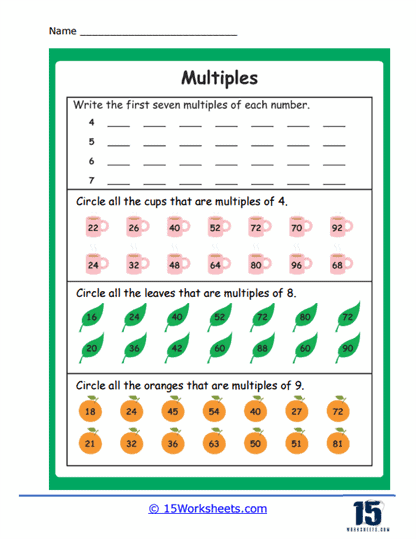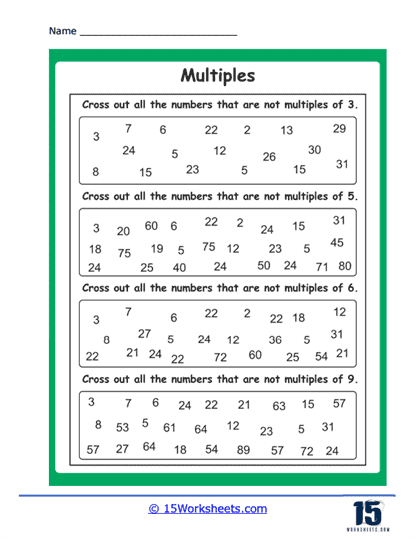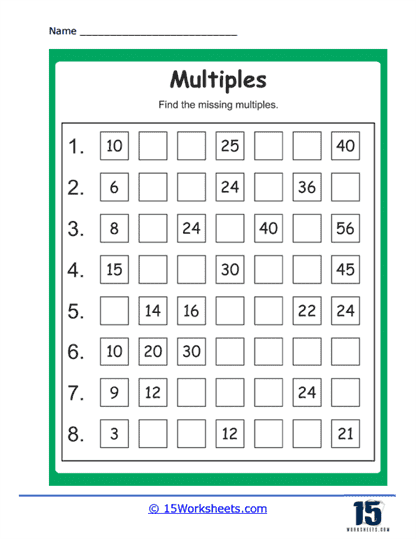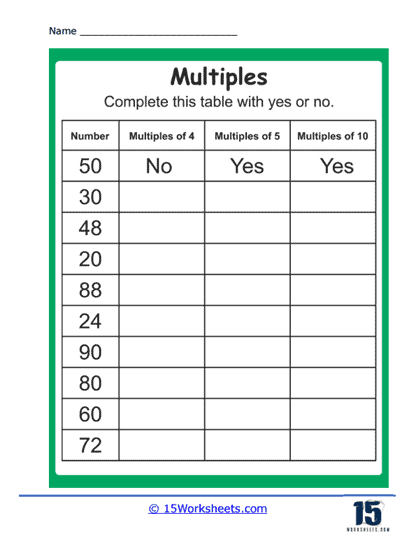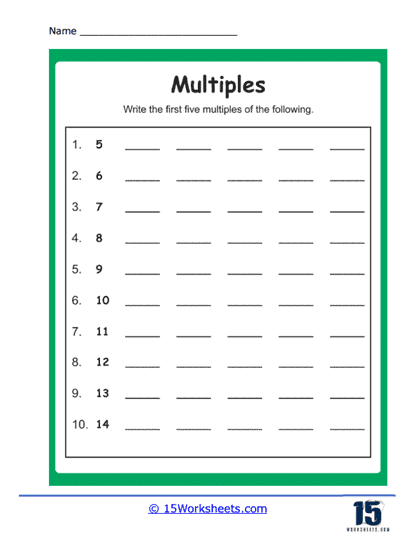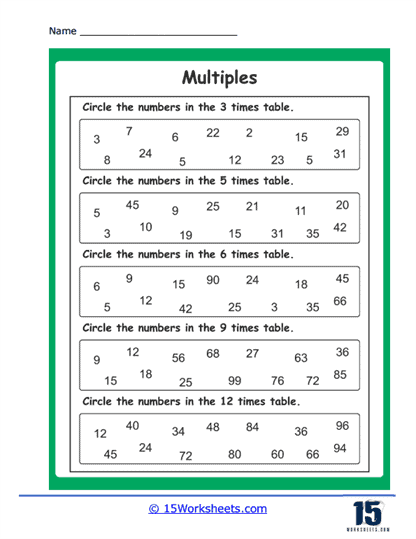Multiples Worksheets
About These 15 Worksheets
Imagine you’re standing at the base of a staircase. Each step you take moves you up by the same number of stairs, and as you continue, the ascent becomes predictable, methodical. This pattern of adding a fixed number of steps mirrors the mathematical concept of “multiples.” It’s a simple yet fundamental idea: the process of repeatedly adding the same number to itself. Though the term “multiples” may initially seem technical, at its core, it’s about consistent repetition-whether adding 3s, 5s, or any number-and climbing higher with each step. To make learning this essential skill more accessible and engaging, educators have created tools like multiples worksheets, which provide structured, interactive ways to grasp the concept.
Multiples are deeply embedded in the fabric of mathematics. To illustrate, think of the number 3. If you continuously add 3 to itself-3, 6, 9, 12, and so on-you generate a series of multiples of 3. These numbers are nothing more than results of adding 3 over and over, much like hopping up that staircase. But while this process is simple to understand, developing a strong familiarity with it requires practice, and that’s where multiples worksheets become invaluable. These worksheets serve as essential practice grounds, providing opportunities for learners to repeat and reinforce their understanding of multiples in a variety of contexts.
When you first dive into these worksheets, you’ll encounter exercises designed to introduce and solidify the basics. One such exercise might ask you to list the first ten multiples of a given number, say 5. Through this type of straightforward practice, you internalize the process of repeated addition, recognizing patterns as you go. By regularly engaging in these problems, you begin to understand multiples not just as an abstract mathematical term, but as a predictable, manageable concept that builds on itself.
As you progress, the worksheets introduce more advanced challenges, prompting deeper thinking and greater problem-solving skills. For instance, a task might present you with a group of numbers and ask which ones are multiples of 7. This type of exercise shifts the focus from generating multiples to recognizing them, honing your ability to discern patterns and identify relationships between numbers. These problems cultivate analytical thinking, teaching you to sift through information and spot the right connections, an essential skill in more advanced mathematical areas.
Word problems also make frequent appearances in multiples worksheets, adding an element of real-world application to the concept. Consider a problem like, “Sarah buys 4 candies every day. How many candies will she have after a week?” By applying your understanding of multiples, you can easily determine that after seven days, Sarah will have 28 candies (7 days × 4 candies per day). This type of exercise illustrates how multiples aren’t just abstract numbers on a page, but practical tools that help solve everyday problems-from counting candies to planning schedules and budgets.
Another type of exercise you might encounter involves pattern recognition, an area where multiples play a starring role. A worksheet might give you a sequence of numbers with missing values and ask you to identify the missing numbers based on a given multiple. By recognizing the consistent pattern, you not only reinforce your understanding of multiples but also improve your ability to detect numerical patterns, a skill that becomes increasingly important in advanced mathematical topics like algebra and number theory. This kind of problem stretches your mind, encouraging logical reasoning and a deeper appreciation for the order hidden within numbers.
The benefits of working through multiples worksheets extend far beyond immediate problem-solving. At their core, these worksheets offer a structured way to practice thinking systematically and methodically. Each time you solve a problem, you strengthen your understanding of multiples, making them more intuitive. Over time, this repetitive practice sharpens your ability to recognize patterns and relationships between numbers, laying a strong foundation for more complex mathematical concepts, such as least common multiples (LCM), ratios, and proportions. With a solid grasp of multiples, you’ll be better prepared to tackle these more advanced topics with confidence and ease.
Multiples are not only crucial in the classroom-they appear throughout daily life. Take, for example, the world of music. When you listen to a song, you might tap your foot to the rhythm. That rhythm often follows predictable patterns based on multiples. The beat you’re tapping to may repeat every 4 or 8 counts, and understanding how multiples work can help you predict when the next beat will drop, enhancing your sense of timing and rhythm.
In other everyday situations, multiples are just as relevant. Imagine you’re planning a party and need to arrange chairs in rows of 8. Knowing how multiples work allows you to quickly calculate how many chairs you’ll need for, say, 5 rows (40 chairs in total). This concept ensures you have the correct number of chairs without leaving any extras or needing to scramble for more at the last minute.
Even grocery shopping involves multiples. Suppose each packet of cookies contains 10 cookies, and you purchase 3 packets. Using your understanding of multiples, you can easily calculate that you now have 30 cookies. In this way, multiples aren’t just mathematical exercises-they’re tools that simplify everyday tasks, from organizing events to managing your budget.
In sports, multiples can also be found in training routines. A basketball player might practice shooting by taking 15 shots in a set. If the player repeats this set 4 times, understanding multiples allows them to quickly determine they’ve taken 60 shots in total. This type of calculation not only helps athletes track their progress but also encourages discipline and structured practice.
What is a Multiple?
In mathematics, a multiple of a number is the product obtained when that number is multiplied by an integer. Simply put, if you have a number
a and you multiply it by any integer, the result is a multiple of a. For example, the multiples of 3 are found by multiplying 3 by different integers, such as 3 x 1 = 3, 3 x 2 = 6, 3 x 3 = 9, and so on. Multiples can be positive, negative, or zero depending on the integer used in the multiplication. It’s important to note that every number is a multiple of itself because multiplying a number by 1 yields the number itself.
Characteristics of Multiples
One key feature of multiples is that they continue infinitely. This is because there are an infinite number of integers to multiply by. For any number a, there is no limit to how large or small its multiples can be. Moreover, all multiples of a given number are evenly divisible by that number. For example, any multiple of 5 is divisible by 5 without leaving a remainder. This property helps in solving problems involving divisibility, common multiples, and greatest common divisors.
Example 1: Multiples of 4
Let’s take 4 as an example. The multiples of 4 are obtained by multiplying 4 by 1, 2, 3, 4, etc. So, the multiples of 4 are:
4 x 1 = 4
4 x 2 = 8
4 x 3 = 12
4 x 4 = 16
4 x 5 = 20
These multiples go on indefinitely. Each of these numbers can be divided by 4, confirming that they are indeed multiples. Additionally, if we consider negative integers, the multiples of 4 can also include negative numbers like 4 x -1 = -4, 4 x -2 =-8 and so on.
Example 2: Multiples of 7
Let’s consider the number 7. To find its multiples, we multiply 7 by positive and negative integers. The first few multiples of 7 are:7 x 1=7,7 x 2=14,7 x 3=21,7 x 4=28,7 x 5=35
As with 4, the multiples of 7 extend infinitely in both positive and negative directions. For instance, 7 x -1 = -7 and 7 x -2 = -14. Again, each of these multiples is divisible by 7.
Common Multiples
Sometimes, we are interested in the multiples that two or more numbers share. These are called common multiples. For instance, 4 and 6 have common multiples because some numbers, like 12 and 24, are multiples of both. Finding the least common multiple (LCM) of two numbers can help solve problems related to synchronization or matching quantities, like when two events need to occur at the same time in periodic intervals.

